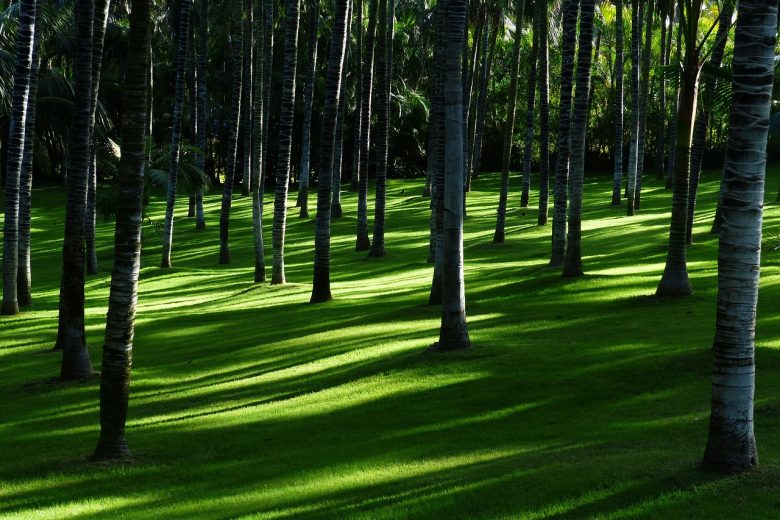Shade trees are essential for pastures, providing numerous benefits such as cooling shade for livestock, reducing soil erosion, enhancing the landscape, and promoting biodiversity. If you’re looking to establish shade quickly, selecting fast-growing species is key.
In this comprehensive guide, we will explore ten of the best fast-growing shade trees for your pasture. Each tree is chosen for its rapid growth, adaptability, and the benefits it brings to your land.
10 Fast-Growing Shade Trees For Your Pasture
Here are the growing shade trees for your pasture;
1. Silver Maple (Acer saccharinum)
Overview
The Silver Maple is known for its rapid growth and adaptability to various soil types, making it an excellent choice for pastures. It can grow up to 50-70 feet tall and 30-50 feet wide, providing ample shade in a relatively short period.
Benefits
- Rapid Growth: Can grow up to 3-7 feet per year.
- Shade: Offers extensive canopy coverage.
- Soil Tolerance: Thrives in wet, poorly drained soils.
Care Tips
- Planting Location: Prefers full sun but can tolerate partial shade.
- Watering: Requires regular watering when young; more drought-tolerant once established.
- Maintenance: Prune regularly to maintain a strong structure and prevent breakage.
Read Also: Top 8 Biggest Agricultural Companies In USA [Ranking]
2. Hybrid Poplar (Populus deltoides x Populus nigra)
Overview
Hybrid Poplars are some of the fastest-growing trees, capable of reaching 40-50 feet in just a few years. They are ideal for quick shade and windbreaks in pastures.
Benefits
- Exceptional Growth Rate: Can grow 5-8 feet per year.
- Shade and Shelter: Provides substantial shade and acts as a windbreak.
- Soil Adaptability: Grows well in a variety of soil conditions.
Care Tips
- Planting Location: Full sun for optimal growth.
- Watering: Needs regular watering during establishment; moderately drought-tolerant.
- Maintenance: Monitor for pests and diseases, which can be common in hybrid varieties.
3. Willow (Salix spp.)
Overview
Willows, particularly the Weeping Willow, are renowned for their fast growth and graceful appearance. They are well-suited to areas with ample water, such as near ponds or streams in pastures.
Benefits
- Fast Growth: Can grow 3-5 feet per year.
- Moisture Loving: Ideal for wet areas and helps manage waterlogged soils.
- Shade: Offers broad, dense shade.
Care Tips
- Planting Location: Prefers full sun and moist soil.
- Watering: Requires consistent moisture, especially when young.
- Maintenance: Prune to remove dead branches and shape the tree.
4. Eastern Cottonwood (Populus deltoides)
Overview
The Eastern Cottonwood is another member of the Poplar family known for its rapid growth and large stature. It is excellent for creating shade quickly in expansive pastures.
Benefits
- Rapid Growth: Can grow 5-8 feet per year.
- Extensive Shade: Its large leaves provide excellent shade coverage.
- Soil Versatility: Tolerates a wide range of soils, including poor and compacted soils.
Care Tips
- Planting Location: Full sun.
- Watering: Requires regular watering when young; becomes more drought-tolerant as it matures.
- Maintenance: Prune regularly to maintain health and structure.
5. American Sycamore (Platanus occidentalis)
Overview
The American Sycamore is a robust tree known for its rapid growth and striking appearance. Its large, spreading canopy makes it ideal for providing shade in pastures.
Benefits
- Fast Growth: Can grow 2-6 feet per year.
- Wide Canopy: Provides extensive shade coverage.
- Hardy: Resistant to pollution and tolerant of a variety of soil types.
Care Tips
- Planting Location: Prefers full sun.
- Watering: Regular watering during establishment; moderately drought-tolerant.
- Maintenance: Prune to remove dead wood and maintain structure.
6. Red Maple (Acer rubrum)
Overview
The Red Maple is valued for its fast growth, vibrant fall color, and adaptability. It is a versatile tree that provides excellent shade and enhances the aesthetic of your pasture.
Benefits
- Rapid Growth: Can grow 1-3 feet per year.
- Adaptability: Tolerates a variety of soil conditions.
- Shade: Provides substantial shade with its broad canopy.
Care Tips
- Planting Location: Full sun to partial shade.
- Watering: Keep soil consistently moist, especially when young.
- Maintenance: Prune in late winter or early spring to shape the tree and remove dead branches.
7. Green Ash (Fraxinus pennsylvanica)
Overview
The Green Ash is a hardy, fast-growing tree that is highly adaptable to different soil types and conditions. It is known for its ability to establish quickly and provide ample shade.
Benefits
- Fast Growth: Can grow 2-3 feet per year.
- Durable: Resistant to various soil conditions and pollution.
- Shade: Develops a wide, spreading canopy.
Care Tips
- Planting Location: Full sun for best growth.
- Watering: Regular watering during establishment; drought-tolerant once mature.
- Maintenance: Prune to maintain structure and remove dead or diseased branches.
8. Tulip Tree (Liriodendron tulipifera)
Overview
The Tulip Tree, also known as the Tulip Poplar, is one of the tallest and most majestic native trees. It grows quickly and provides significant shade with its large, tulip-shaped leaves.
Benefits
- Rapid Growth: Can grow 2-3 feet per year.
- Tall and Majestic: Can reach heights of 70-90 feet, providing extensive shade.
- Aesthetic Appeal: Beautiful flowers and unique leaves add to the visual appeal.
Care Tips
- Planting Location: Full sun for optimal growth.
- Watering: Requires regular watering during establishment.
- Maintenance: Prune to shape and remove dead wood.
9. Northern Red Oak (Quercus rubra)
Overview
The Northern Red Oak is a fast-growing oak species that is both hardy and long-lived. It is known for its robust structure and the dense shade it provides.
Benefits
- Fast Growth: Can grow 2-3 feet per year.
- Long-Lived: Can live for several centuries.
- Shade: Its broad canopy offers substantial shade.
Care Tips
- Planting Location: Prefers full sun.
- Watering: Regular watering during the first few years.
- Maintenance: Prune to maintain a strong structure.
10. Empress Tree (Paulownia tomentosa)
Overview
The Empress Tree, also known as the Royal Paulownia, is one of the fastest-growing trees in the world. It can provide rapid shade and has beautiful purple flowers.
Benefits
- Exceptional Growth Rate: Can grow 10-15 feet per year.
- Shade and Beauty: Provides extensive shade and stunning flowers.
- Soil Tolerance: Thrives in various soil types.
Care Tips
- Planting Location: Full sun for best growth.
- Watering: Requires regular watering when young.
- Maintenance: Prune to encourage a strong structure and remove dead wood.
Why are fast-growing shade trees important for pastures?
Fast-growing shade trees are crucial for pastures because they provide quick relief from the sun for livestock, reducing heat stress and improving overall animal health and productivity. Additionally, these trees can help control soil erosion, enhance the landscape, and support biodiversity by providing habitats for various wildlife species. Quick-growing varieties are particularly beneficial as they establish faster and start offering these benefits sooner compared to slow-growing species.
What are some common fast-growing shade trees suitable for pastures?
Some common fast-growing shade trees ideal for pastures include:
- Silver Maple (Acer saccharinum)
- Hybrid Poplar (Populus deltoides x Populus nigra)
- Willow (Salix spp.)
- Eastern Cottonwood (Populus deltoides)
- American Sycamore (Platanus occidentalis)
- Red Maple (Acer rubrum)
- Green Ash (Fraxinus pennsylvanica)
- Tulip Tree (Liriodendron tulipifera)
- Northern Red Oak (Quercus rubra)
- Empress Tree (Paulownia tomentosa)
These species are selected for their rapid growth, ability to provide significant shade, and adaptability to various soil and environmental conditions.
How do I ensure the fast-growing trees establish well in my pasture?
Answer: To ensure successful establishment of fast-growing trees in your pasture, follow these steps:
- Choose the Right Location: Plant trees in areas where they will receive adequate sunlight and have enough space to grow without competing excessively with other plants.
- Prepare the Soil: Ensure the soil is well-drained and fertile. Amend it with organic matter if necessary.
- Water Regularly: Provide consistent moisture, especially during the first few years. Young trees need regular watering to establish deep root systems.
- Protect from Livestock: Use tree guards or fencing to protect young trees from being trampled or eaten by livestock.
- Mulch: Apply a layer of mulch around the base of the trees to retain moisture, regulate soil temperature, and reduce weed competition.
- Prune: Regularly prune the trees to promote strong, healthy growth and remove any dead or diseased branches.
What should I consider when choosing a fast-growing shade tree for my pasture?
Answer: When choosing a fast-growing shade tree for your pasture, consider the following factors:
- Growth Rate: Look for species known for their rapid growth.
- Mature Size: Ensure the tree’s mature size fits your space and does not interfere with structures or other plants.
- Soil and Climate Compatibility: Select trees that thrive in your local soil type and climate conditions.
- Maintenance Needs: Consider the tree’s maintenance requirements, such as watering, pruning, and pest management.
- Shade and Canopy: Evaluate the tree’s canopy spread and density to ensure it provides adequate shade.
- Root System: Choose trees with root systems that won’t interfere with pasture activities or damage infrastructure.
Are there any potential downsides to planting fast-growing trees in pastures?
Answer: While fast-growing trees offer many benefits, there are potential downsides to consider:
- Weaker Wood: Some fast-growing trees, like willows and poplars, tend to have weaker wood that may be more prone to breaking during storms.
- Shorter Lifespan: Many fast-growing species have shorter lifespans compared to slower-growing trees.
- Invasiveness: Certain fast-growing trees can be invasive and spread aggressively, potentially outcompeting native vegetation.
- Pest and Disease Susceptibility: Fast-growing trees may be more susceptible to certain pests and diseases, requiring vigilant monitoring and management.
- Maintenance: These trees often require more frequent pruning and maintenance to manage their rapid growth and prevent structural issues.
By carefully selecting species and providing proper care, you can mitigate these downsides and enjoy the benefits of fast-growing shade trees in your pasture.
Conclusion
Choosing the right shade trees for your pasture can significantly enhance the environment for your livestock, improve the landscape, and provide long-term benefits. The ten trees listed above are excellent choices for fast-growing shade, each offering unique benefits and characteristics.
When selecting a tree, consider your specific needs, climate, and soil conditions to ensure the best growth and health of your new additions. With proper care and maintenance, these trees will thrive and transform your pasture into a more comfortable and visually appealing space.




